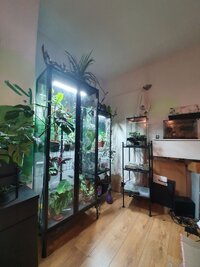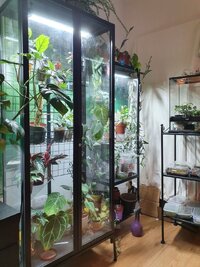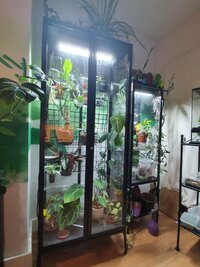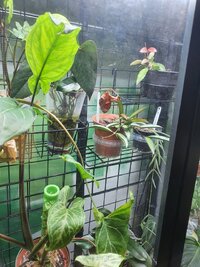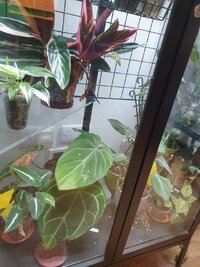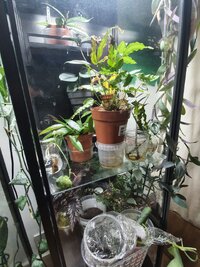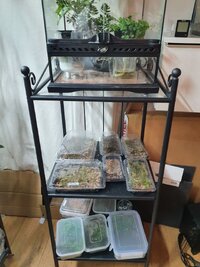Okay, I've taken some quick snaps, attached below - not very '#aesthetic' but since this isn't instagram then I'm sure everyone here is fine with that

Everything here is still very much a work in progress, not a finished piece - the cabinets were constructed in a bit of a hurry as I wanted to prioritise having plant-space with consistent light/temp/humidity in time for last winter. I've since made improvements to them in an iterative sort of way, and have a great deal more planned, once my time / energy / enthusiasm / budget all permit it at the same time! I currently use them for for propagation, plant rehabilation, and a more permanent home for sensitive / humidity-loving plants. They definitely need a bit of a reorganise, and they're currently skewed more towards function than decoration, but the plants are beautiful either way 💚
The first three attached pictures are just the cabinet corner - Milsbo on the left, then Rudsta, and then a discontinued Ronnskar. The Ronnskar isn't a cabinet but it's similarly metal-and-glass so I've been grabbing them second-hand as they're great surfaces for displaying plants on and fit the general vibe of my living room! This one is being kept in the cabinet corner because it's currently holding propagations ultimately intended for terrariums, and the props will benefit from the consistent light that comes from the cabinets. I've also got an Exo Terra nano viv on the Ronnskar (free + 2nd hand) and I'm planning to scape it as a terrarium, but since the Ronnskar is a little bit wobbly, this may need to wait until I've affixed it to the wall. (And for anyone curious, on the shelf next to it is one of my isopod enclosures, featuring my first attempt at hardscape constructed from multiple elements pieces of stone and wood, attempting to give the impression of a damaged tree on a mountain-top.)
Next two photos are Milsbo contents, then one of Rudsta contents, and finally Ronnskar contents. This post gets long, so I've added subheadings!
Lighting (and other bells and whistles)
The Milsbo has an Arcadia Jungle Dawn LED Bar 22w, and the Rudsta has the 15w version. Both are connected to the same timer plug, which gives them two shortish photo periods, one in the morning and one in the evening. The cabinets are next to the table I'm using as a desk, and this is arranged such that I need to use other artificial lighting less often when I'm working from home. The lights are held up using hooks on neodymium magnets, and the wires run out through the Milsbo's side door hinge and the Rudsta's small side gap. As the cabinets are designed to be display cabinets with lights inside them, they do have holes, but unfortunately not ones which accomodate the cables I have. Drilling new holes (or expanding existing ones) is certainly on my agenda at some point, but given it involves drilling holes in metal, and thus needing to be careful about sharp metal shavings, properly sealing the remaining edges to prevent rust, etc, it's not something I just want to do casually of an evening!
I don't have any humidifiers, fans, or weather-stripping; I do have hygrometers for monitoring the humidity levels, though, and I find that when the plants are being well-watered, the humidity levels are just fine. I also suspect that if I did add weather-stripping without also adding fans, I'd have higher humidity, but also mould problems. I don't currently heat them either; the LED bars provide a gentle heat, and the enclosed environment means they're relatively stable.
Milsbo
The Milsbo has none of its original glass shelves remaining. I have one acrylic corner shelf which was cut to fit the existing shelf supports; I've seen some cabinet builds which layer these see-through shelves and they do look beautiful, but they seem problematic for growing longer / taller plants. The corner shelves also, unfortunately, do not work with my other shelving solution - wire frames, hanging from the top via heavy-duty neodymium magnetic hooks, and held together with cable ties. The wire frames are sturdy and coated with some kind of rubber or plastic (manufacturer did not specify), and give a lot of freedom for plant placement. They came with the wire baskets and shelves I've got attached to them, and have room for more attachments. A lot of the earlier IKEA greenhouse cabinet builds used the Skadis pegboard for this, but as those were made of coated MDF, people found that in the longer term they had problems with swelling and mould from the ambient moisture.
I've seen some Milsbo setups where people have full-width shelves and a light hanging under each shelf, but this feels excessive for the plants I have - I just arrange my plants so the ones that prefer shadier spots are lower down, and the ones with high light tolerance (or interesting responses to high light) are near the top. This seems to be working for me so far, so I'm glad I didn't get more than one light per cabinet, as I'm also keen on energy-efficiency! Another Milsbo shelf variation I've seen is wire-rack shelving, to allow for greater air movement between levels; this can range from custom-commissioned ones with personalised lettering, to oven racks or storage shelving cut to size.
I like the wire rack because it serves as a sort of all-purpose trellis to grow my plants up. I at one point considered covering it with sphagnum moss, but both the setup and maintenance felt like too much. Since then, I've had the idea for ultimately turning it into a paludarium, but the scope of that project is far beyond my current capacity, and I'm focusing on smaller terrariums and aquascapes first before trying something of that ambitious scale.
Rudsta and Ronnskar
I've kept one of the original Rudsta shelves for the time being, but also have magnetic shelves - since the Rudsta has a metal back rather than a glass one, no wire frame or pegboard is needed to have moveable shelves! I believe these ones were sold as spice racks to attach to the front of fridges. I used to have some plants in there hanging down from magnetic hooks but those are now elsewhere as they outgrew the space. The cubby underneath is where I store various bits of plant paraphernalia. I'm going to put one of the Drona boxes in it (made to go in Kallax but I checked the dimensions and it'll fit).
The Ronnskar is unmodified and as per my above comments it's basically just an extended propagation shelf at the moment.
Post got loooooong and I'm now tired, so gonna stop here, but happy to answer questions etc another time




